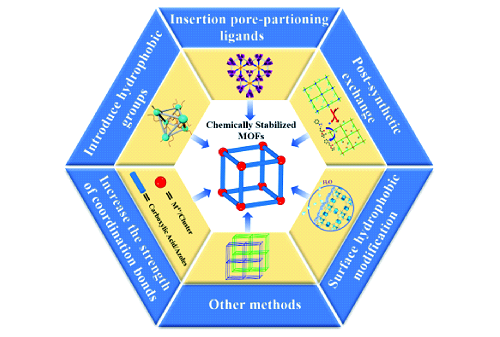 PDF(23677 KB)
PDF(23677 KB)


Synthetic Strategies of Chemically Stable Metal-Organic Frameworks
Mengrui Yang, Yuxin Xie, Dunru Zhu
Prog Chem ›› 2023, Vol. 35 ›› Issue (5) : 683-698.
 PDF(23677 KB)
PDF(23677 KB)
 PDF(23677 KB)
PDF(23677 KB)
Synthetic Strategies of Chemically Stable Metal-Organic Frameworks
Metal-organic frameworks (MOFs) are a new generation of crystalline porous materials with void space structures constructed from metal ions or clusters and organic ligands through coordination bonds, and have been a hot research topic in the field of coordination chemistry over the past two decades. As the novel multifunctional materials, MOFs have been widely used in various fields due to their high porosities, low densities, large surface areas, tunable pore sizes, diverse topological structures and tailorabilities. Although MOFs have many advantages, most of MOFs materials have relatively lower water and chemical stability and cannot maintain their structures under harsh conditions, which greatly restrict their practical applications under moisture-rich conditions. Therefore, chemically stable MOFs materials will have greater application prospects. In recent years, researchers have carried out a lot of exploration in improving the chemical stability of MOFs, and developed some excellent methods to synthesize chemically stable MOFs. This review will mainly focus on the latest research progress in the syntheses of chemically stable MOFs during the past five years.
1 Introduction
2 Synthetic strategies of chemically stable MOFs
2.1 Increase the strength of coordination bonds
2.2 Attaching hydrophobic groups onto the linker
2.3 Using pore-partioning ligands for the pore space partition
2.4 Post-synthetic exchange method
2.5 Hydrophobic surface treatment
2.6 Other methods
3 Conclusion and Outlook

metal-organic frameworks(MOFs) / chemical stability / synthetic strategy
| [1] |
|
| [2] |
|
| [3] |
(朱敦如, 周俊, 杨捷, 包魏魏, 沈旋. 南京工业大学学报(自然科学版), 2007, 29(3): 103.).
|
| [4] |
|
| [5] |
|
| [6] |
(封啸, 任颜卫, 江焕峰. 化学进展, 2020, 32(11): 1697.).
|
| [7] |
|
| [8] |
(赖欣宜, 王志勇, 郑永太, 陈永明. 化学进展, 2019, 31(6): 783.).
|
| [9] |
|
| [10] |
|
| [11] |
|
| [12] |
|
| [13] |
|
| [14] |
|
| [15] |
|
| [16] |
|
| [17] |
|
| [18] |
|
| [19] |
|
| [20] |
|
| [21] |
|
| [22] |
|
| [23] |
|
| [24] |
|
| [25] |
|
| [26] |
|
| [27] |
|
| [28] |
|
| [29] |
|
| [30] |
|
| [31] |
|
| [32] |
|
| [33] |
|
| [34] |
|
| [35] |
|
| [36] |
(张晋维, 李平, 张馨凝, 马小杰, 王博. 化学学报, 2020, 78: 597.).
|
| [37] |
|
| [38] |
|
| [39] |
|
| [40] |
|
| [41] |
|
| [42] |
|
| [43] |
|
| [44] |
|
| [45] |
|
| [46] |
|
| [47] |
|
| [48] |
|
| [49] |
|
| [50] |
|
| [51] |
|
| [52] |
|
| [53] |
|
| [54] |
|
| [55] |
|
| [56] |
|
| [57] |
|
| [58] |
|
| [59] |
|
| [60] |
|
| [61] |
|
| [62] |
|
| [63] |
|
| [64] |
|
| [65] |
|
| [66] |
|
| [67] |
|
| [68] |
|
| [69] |
|
| [70] |
|
| [71] |
|
| [72] |
|
| [73] |
|
| [74] |
|
| [75] |
|
| [76] |
|
/
| 〈 |
|
〉 |